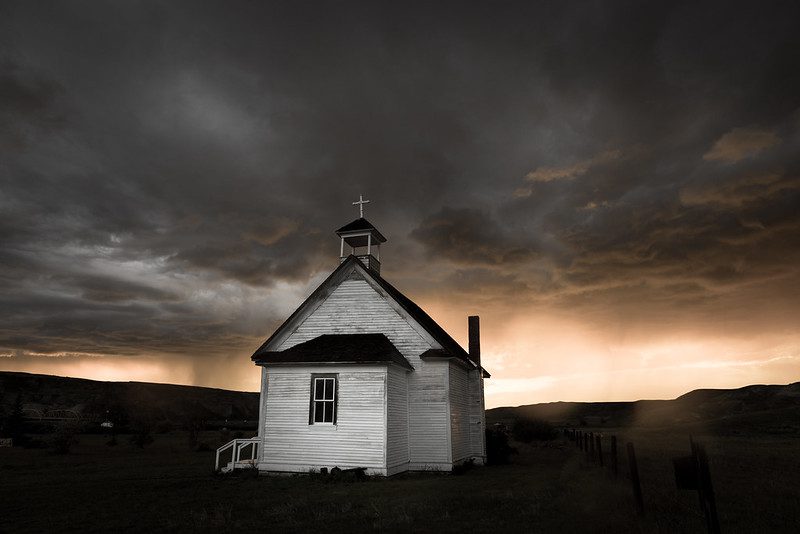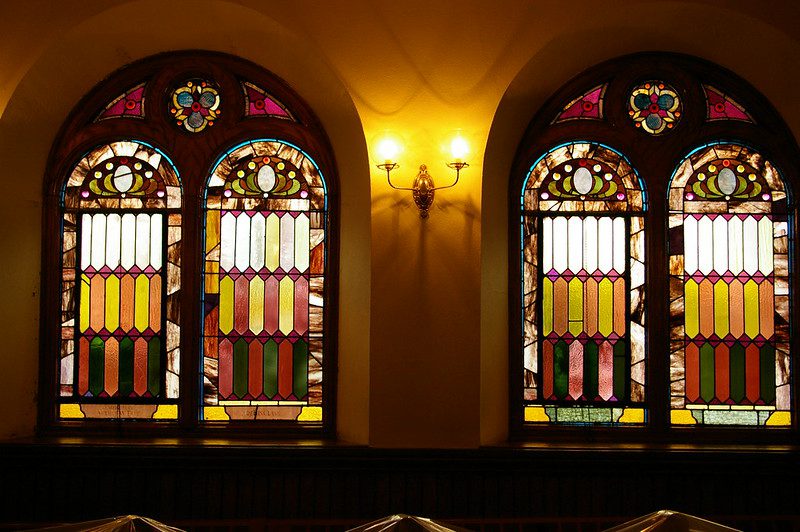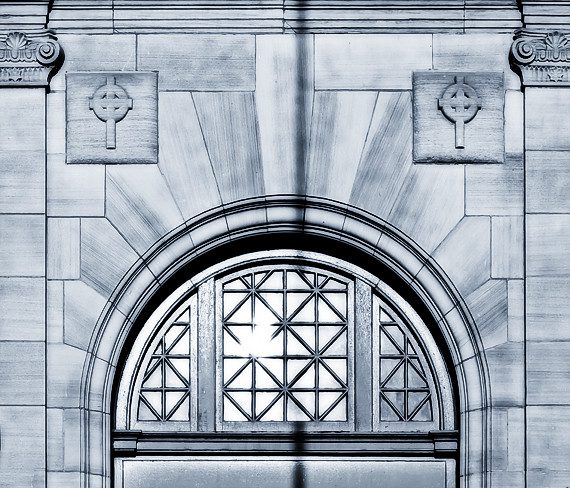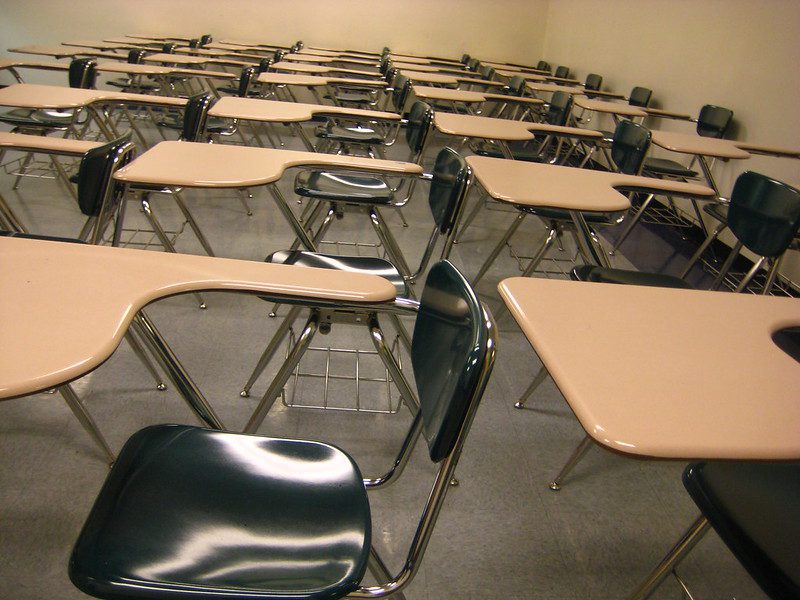
Photo by Flickr user Steve Osmond, CC BY-NC 2.0
When I tell politically progressive friends that I’ve started teaching a course at Harvard about religion’s impact on American politics and public policy, I usually face one of two responses.
The first is an awkward silence—and a quick change of subject. The second is also awkward but comes with an anxiously knowing, usually sotto voce, “So you’re doing abortion and the Christian right—that sort of thing, yes?” When I explain that, no, in fact I’m devoting only a week of the course to the religious right and that I barely mention abortion, it’s usually back to awkward silence again—and the search for a new subject.
In the proper mood, I’m sympathetic to my friends’ reactions. After all, what comes to mind when someone mentions religion and politics nowadays? Aren’t Jerry Falwell, Pat Robertson, Gary Bauer, anti-abortion picketers, and anti-gay marchers probably the first images? Or is it perhaps Bill Clinton, lachrymose at a Washington prayer breakfast last year, earnestly “repenting” his affair with Monica? More recently, what about the House Republicans voting that schools post the Ten Commandments in answer to gun violence? Or the discomfiting sudden embrace of religion by last year’s crop of presidential candidates and their minions?
It’s not a list designed to warm progressive hearts. But as I’ve come to discover, it’s far from all we need to know about American religion. Contrary to what many may think, religion is alive and well in America—and a good deal of what it says and does is strikingly progressive.
Here’s what surprises a lot of my progressive friends:
- Last spring, in the midst of Easter week and Passover, bystanders on Beverly Hills’ Rodeo Drive gaped from behind the store windows of Fendi, Armani and the like, as 150 rabbis, Catholic priests and Protestant ministers in full flowing robes filed down the street. At the head of the procession, a 25-foot-long banner declared “ALL RELIGIONS BELIEVE IN JUSTICE.” “Shoppers froze in their tracks,” one participant remembers, and local TV and radio crews converged on the scene. The march, organized by Clergy and Laity United for Economic Justice (CLUE), a coalition of ministers, priests and rabbis that proved decisive in getting the city’s landmark living-wage ordinance passed in 1997, stopped first in front of two hotels that had agreed, after a long struggle, to sign the new union contract. Here they placed bowls filled with milk and honey—biblical symbols of the promised land—along with baskets of Easter lilies. But to a hotel that refused to sign the new contract, they instead brought bitter herbs, the Passover symbol of slavery. Within three weeks, all the targeted hotels signed hefty new contracts with their low-wage workers.
- In Washington, D.C., a progressive evangelical group called Sojourners regularly challenges conservative evangelicals on issues from income, gender and racial equality to support for organized labor and the environment. Four years ago, the 25-year-old group launched Call to Renewal, which has come into dozens of communities across the country at the invitation of local church groups (and even politicians) to stop gang violence, foster urban renewal, help secure jobs for minority youth, and fight drug abuse. Evangelicals have a long tradition of concern for the poor, notes the Rev. Emory Searcy, national field organizer for the group. But to Searcy, a black Baptist minister, too many evangelicals “got hijacked by the right” in recent years. “We’re just asking them to recapture their own history.”
- Over on Capitol Hill, as part of an international, multi-denominational campaign, the religious alliance Jubilee 2000/USA is pressing Congress to cancel the foreign debts of the world’s poorest countries. The group takes its name from the Old Testament example of the Jubilee Year, when debts were to be forgiven and slaves set free. It is endorsed by an impressive list of prominent religious leaders including Pope John Paul II and South Africa’s Archbishop Desmond Tutu. Jubilee 2000/USA has also reached out to add endorsements from the AFL-CIO and the U.S. Conference of Mayors. The Jubilee 2000/USA movement was highly visible and influential in the November 1999 Seattle WTO protests and, logically enough, in the April 2000 Washington, D.C., International Monetary Fund and World Bank protests.
- In East Brooklyn, New York City, a number of mostly black and Hispanic activist ministers and laypeople working together as the Nehemiah Project have raised millions in loans from their local churches and national denominations to build or rehabilitate nearly 5000 units of low-income housing over the past 15 years. The group’s success is now being copied by new Nehemiah Projects in other cities around the country.
Faith-based groups from Delaware to Georgia are helping to organize thousands of mainly Black and Latino workers in the enormous, low-wage poultry-processing industry. According to the U.S. Department of Labor, 60 percent of poultry-processing plants regularly violate wage and hour laws, and workers who try to join unions are routinely harassed or fired. Working together as the Poultry Justice Alliance, these groups use well-publicized local rallies and prayer vigils (as well as lobbying pressure brought by their national denominations) to help the industry’s workers secure basic labor rights. The Poultry Justice Alliance, in turn, is just one of nearly four dozen local faith-based groups in 25 states that coordinate their efforts on behalf of workers through the Chicago-based National Interfaith Committee for Worker Justice.
America’s Catholic bishops (see article on CCHD)—mainly through their Catholic Campaign for Human Development—contribute between $10 million and $20 million a year to grassroots progressive groups around the country, working on everything from inner-city community renewal in Chicago to tenant organizing in California. And millions more flow each year from Catholic orders like the Maryknolls and Jesuits as well as mainline Protestant denominations and liberal Jewish groups. One guidebook for progressive activists, for example, lists nearly eight dozen major religious funding sources that might support their work.
In short, there’s a great deal going on in America’s religious life that liberals should know more about—and support. Yet the fact is we often do neither.
God and Country
Many once held that religion in the United States was in terminal decline, thanks to the secularizing forces of urbanization, industrialization, scientific explanation, and consumer culture. But according to nearly half a century of Gallup polling data about Americans and religion:
- Nine out of 10 Americans say they’ve never doubted the existence of God.
- Eight out of 10 believe they’ll be called before God on Judgment Day to answer for their sins.
- Seven in 10 say they’re current church or synagogue members.
- Four in 10 say they worship at least weekly (six in 10 say at least monthly) as members of a religious congregation.
To be sure, the 1960s and 1970s saw a drop in America’s religious membership as part of a general decline of confidence and participation in civil society, which Robert Putnam has described, with some alarm, as a loss of the nation’s “social capital.”
Mainline Protestants—Methodists and Presbyterians, particularly—lost about a quarter of their members from the 1960s through the 1980s. Catholicism suffered its own decline among Americans of European descent but compensated with a dramatic inflow of Hispanic members. Jews lost significant portions of their religiously active population, though arguably many have found new sources of Jewish identification through Israel and the memory of the Holocaust.
By the early 1990s, however, those declines had not only stopped, they had begun to reverse themselves—led by the same baby boomers who had earlier abandoned organized religion. David Roozen of Hartford Seminary, surveying Americans born between 1945 and 1954, has found that regular church attendance among these boomers rose dramatically, from 33 percent in 1975 to 41 percent in 1990, and it appears to be rising still.
But if Americans remain overwhelmingly religious, our faiths still come in a rainbow of colors. Roughly a quarter of Americans tell pollsters they’re mainline Protestants, another quarter that they’re fundamentalist Protestants, and a quarter that they’re Catholics. About 10 percent are black Protestants, 2 percent are Jews, 2 percent are Mormons, 1 percent are Orthodox Christians, and another 1 or 2 percent identify with “other religions” – mostly Islam, Buddhism, and Hinduism. (Barely one-tenth of Americans say they have no religious identity.)
At first glance, of course, those numbers make America an overwhelmingly Christian country—more Christian, in fact, than India is Hindu, Israel is Jewish, or Latin America is Catholic. However, that massive “Christian majority,” as the Christian right likes to call it, is—and always has been—deeply and fractiously divided. What’s more, the divisions aren’t just liturgical or theological. There are also sharp—and long-enduring—differences in the political and social beliefs of the denominations.
Political analyst Kevin Phillips’s latest book, The Cousins’ Wars, traces the origin of the divides among progressive, liberal, and conservative Protestant denominations all the way back to the English Revolution. In America’s post-Civil War period, science and industrialization led to new divisions as well as the deepening of older ones, as the defeated South—still home today to the majority of America’s fundamentalists—hardened into religious as well as political conservatism.
Meanwhile, mainline Protestants openly embraced not only religious ecumenism but also the idea that science was reconcilable with religious belief. That openness in turn fueled support for the Social Gospel movement, which was central in popularizing the reformist idea of government during the Progressive era.
Likewise, modern Catholic interest in liberal politics and public policy can trace its own genesis to the 19th-century encyclical Rerum Novarum, to Father John Ryan’s turn-of-the-century work on living wages, and to Vatican II in the 1960s. In the midst of the Reagan era, the Catholic Church’s powerful voice on social justice issues was epitomized by the U.S. bishops’ influential and prophetic declarations on economic justice and nuclear war.
Faith and Progressivism
Over the past 20 years, that history has been largely forgotten in our alarm over the Christian right. Yet it takes only a casual reading of major denominational teachings to see just how consistently progressive the faiths of millions of Americans remain—especially when compared to Democratic Party platforms, policies and presidents in the last 30 years.
Here, for example, is an excerpt on “The Economic Community,” from the core faith teachings of the 10-million-member United Methodist Church, the largest of America’s mainline Protestant denominations:
“We claim all economic systems to be under the judgment of God no less than other facets of the created order. Therefore, we recognize the responsibility of governments to develop and implement sound fiscal and monetary policies that provide for the economic life of individuals and corporate entities, and that ensure full employment and adequate incomes with a minimum of inflation. We believe private and public enterprises are responsible for the social costs of doing business, such as employment and environment pollution, and that they should be held accountable for these costs. We support measures that would reduce the concentration of wealth in the hands of a few. We further support efforts to revise tax structures and eliminate governmental support that now benefit the wealthy at the expense of other persons.”
The document goes on to call for limits on the rights of private property, support for collective bargaining, the advancement of more meaningful work and leisure and an end to the celebration of consumerism. It also endorses specific measures to help migrant labor, limit gambling, break up corporate monopolies and increase various forms of “work-sharing” and decentralized management on the job.
Or consider recent statements by the Presbyterian Church (USA), addressed to its three million members. The church’s 1996 General Assembly sought, as one commentator put it:
“Nothing less than a full-scale assault on poverty at home and abroad, endorsing the provision of national health care, increases in the minimum wage and job-training programs, more investment in housing and education, an increase in U.S. international aid, and the development of a comprehensive plan to revive city life in the United States.”
In the midst of the Republicans’ “Contract with America” and President Clinton’s cynical embrace of “triangulation,” the Presbyterians went on to explicitly condemn the “large amount of negative campaigning, neglect of the worthiness of the political vocation, and… the undue influence [of moneyed interests] in the election process.” They called on local clergy to speak out on behalf of “our historical commitment to working for economic justice, peace and disarmament, racial and civil rights…”.
The 2.5-million-member Episcopal Church is as explicitly unconservative as its larger Methodist and Presbyterian brethren, in some cases even more so. Its most recent national convention, for example, condemned Clinton’s welfare reforms, urged new public support for migrant laborers, pressed for strict gun control and the abolition of nuclear weapons, and called for a new trial for Philadelphia death-row prisoner Mumia Abu-Jamal. It also committed the church to supporting local living-wage campaigns and launched a comprehensive study of “the theology of work” to begin redressing not only the material but also the moral and civic inequalities that have emerged in the past three decades.
The 60-million-member Catholic Church—its stance on gender and abortion notwithstanding—is no less progressive than these mainline Protestant denominations on a host of social and political issues. The U.S. Bishops’ pastoral letter “Economic Justice for All,” written a decade ago, for example, is still a benchmark statement. More recently, the Catholic Church was the leader among the religious groups that fought Clinton’s welfare reform bill and was deeply critical of its implications for social justice generally.
Millions of Americans are committed to these progressive organizations or to others that in social teachings are like them (the United Church of Christ, American Baptists, evangelical Lutherans, and several black Baptist and Methodist denominations as well as the smaller Unitarian Universalists, Quakers, and Reform Jews). Yet perhaps the most intriguing feature of this entire progressive wing of American religion is its invisibility to those not part of it.
The reasons for that invisibility aren’t always easy to disentangle. Partly it has had to do with the increasing postwar secularization of the nation’s elites, both in the universities and the press. One study of the elite Washington press corps, for example, found that 86 percent seldom or never attended religious services.
Equally important has been the mental redrawing of the important identity coordinates in American life, especially since the 1960s. Religious affiliation (in particular, denomination) historically served as a distinctive marker of one’s location in America’s social structure, as documented most famously by H. Richard Niebuhr’s Social Sources of Denominationalism.
After World War II, a new spirit of ecumenism and the softening of denominational and religious borders—most celebrated in Will Herberg’s 1955 classic Protestant, Catholic, Jew—set the stage for what Sydney Ahlstrom, in his Pulitzer Prize-winning history of American religion, has called the “coming of post-Protestant America.”
In this world, especially since the 1960s, gender, race, and sexual orientation have taken on new, defining importance – and have powerfully submerged the older coordinates of religion, ethnicity, region, and class. Redressing the inequalities associated with the newly ascendant categories has become the defining mission of liberals and progressives alike.
Misreading the Religious Right
Ever since the rise of, first, Jerry Falwell and his Moral Majority in 1979 and then Pat Robertson and the Christian Coalition, many liberals, in their ignorance, have assumed American religion in general has turned conservative. Why, some have argued, haven’t religious progressives created their own version of the Christian Coalition? It’s a question that misreads what the Christian right has (and hasn’t) accomplished—and why.
First, the secular changes of the 20th century—especially in the years since World War II—have deeply threatened fundamentalists but have had no parallel effect on the liberal denominations. Fundamentalist Protestants draw on a belief in Biblical inerrancy, the emotional reality of imminent salvation, and a deep-seated suspicion of science and government because they compete with religion for authority. All these views, though, are generally alien to mainline Protestant, Jewish, and, in somewhat different ways, Catholic beliefs.
Second, religious progressives have long engaged the political system. As Princeton sociologist Robert Wuthnow and others have repeatedly found, mainline Protestants and Jews, for example, are typically twice as likely as fundamentalists to donate to a party, speak publicly on civic matters, serve in some public leadership role, or belong to politically engaged nonprofit groups.
There’s another issue when it comes to replicating the presumed success of the religious right. Recent polling research suggests that rather than generating a dramatic rise in the ranks of religious conservatives, it is more likely that the Christian right found itself in effect free-riding as traditionally conservative southern voters became Republicans—a realignment that owed more to the civil-rights positions of Lyndon Johnson and Martin Luther King Jr. than to the organizing abilities of Jerry Falwell and Pat Robertson.
Importantly, recent press accounts of the Christian right’s viability suggest it is facing real—potentially fatal—problems after a 20-year run. As a New York Times article on the Christian Coalition reported in the summer of 1999:
The coalition is hobbled by a $2.5 million debt, the departure of most of its experienced leaders and so much turnover in local leadership that it has strong affiliates in no more than seven states, down from the 48 it claimed last year, according to its staff.
And now even its prior assertions to such widespread strength are in doubt. Former national leaders … said … the coalition … distorted the size of its base by keeping thousands of names of dead people, wrong addresses, and duplicates on its list of supporters; printed millions of voter guides that the coalition leaders expected would never be distributed, and hired temporary crews to look busy in the mail room and phone banks to impress reporters and camera crews.
“We never distributed 40 million guides,” says Dave Welch, the coalition’s former national field director …. “State affiliates took stacks of them to recycling centers after the election ….”
People can reasonably disagree about whether the whole Christian-right phenomenon has peaked and is now in decline—or has merely gone underground to focus on state and local politics, as some believe. It’s worth noting, though, that both Paul Weyrich and Cal Thomas—major figures in the movement—now argue publicly that, in fact, the Christian right’s two decades of efforts have “failed” and the time has come for its supporters to refocus primary attention instead on traditional evangelical concerns.
Time to Take Note
Meanwhile, America’s progressive religious community goes on—for the most part ignored by those who like to think of themselves as progressive but who have no connection to the nation’s religious world. Of course, one can’t count all the members or leaders of these churches and synagogues as avid supporters of their denominations’ official views – far from it. In truth, like the Democratic Party or any labor union, progressive religion finds that large numbers of its constituents are indifferent, even sometimes hostile, to the voices of their leaders.
Yet the central fact remains: In an era when progressive voices seem few in number, when many progressive organizations struggle to meet payrolls, let alone advance agendas, America’s progressive religious world represents a large body of committed and caring human beings—deeply bound, out of their own understanding of the connection between justice and the divine—who seek a world most of us could generously affirm.
Like the rest of us, they struggle with their own limitations, their own internal conflicts and weaknesses. Yet time and again at crucial moments in American history, these same communities have risen up to resist abuses of human dignity and justice in the world around them.
Tocqueville, back in the 1830s, clearly saw this feature of American religion already alive and thriving—and he approved. “Religion in America,” he shrewdly reported, “takes no direct part in the government of society, but it must be regarded as the first of their political institutions.” At the dawn of a new millennium, there’s a lesson in the Frenchman’s canny insight that many of us have yet to understand.





Comments